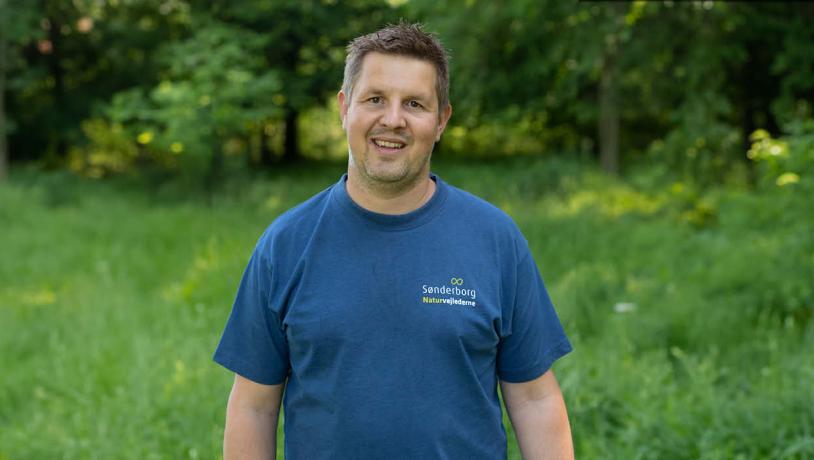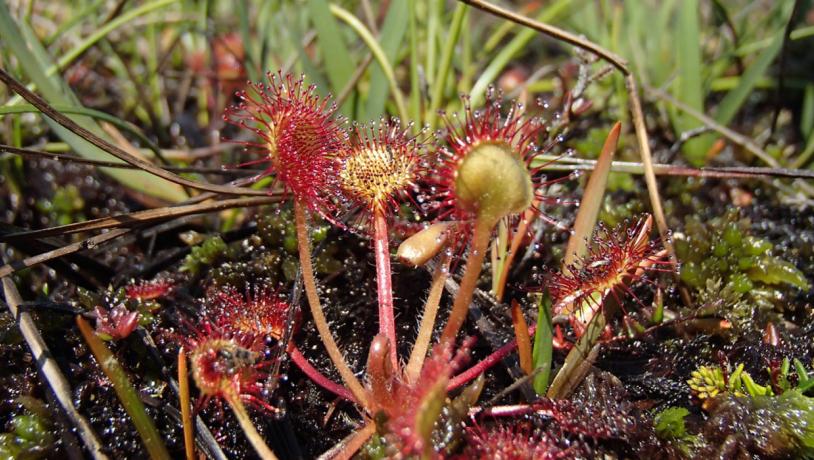A dark walk on South Als
Take a break from artificial light, television and computer- experience the darkest darkness!

The late summer on Kværs Hede, where the heather is in full bloom, is a multitude of beautiful violet colours.
Nature guide Rasmus Ladekjær Nielsen is happy to share his experiences from the nature area Kværs Hede and Plantage.
Hvis man lige som jeg er født og opvokset i Midtjylland, så har Kværs Plantage sikkert en særlig plads i hjertet blandt alle de fantastiske naturperler, der findes i Sønderborg Kommune. Det skyldes, at Kværs Plantage er en granplantage i modsætning til de øvrige skove i kommunen, der primært er bøgeskove. Den dunkle stille og til tider dystre granskov får altid mig til at tænke tilbage på barndommens utallige hulebyggerier og undersøgelser af rævegrave.
Kværs Plantage er gemt godt i Sønderborg Kommunes vestlige del. Landsbyen Kværs ligger på skellet af et landskab, der er formet af istiden. Øst for byen er de 70 meter høje morænebakker - Kværs Bakker, og mod vest strækker de flade hedesletter sig ud. Det er på disse hedesletter, at plantagen er plantet for godt 100 år siden for at forhindre en vandreklit i at brede sig. I dag består plantagen af en blanding af forskellige arter af nåletræer.
Inde midt i plantagen åbner den sig helt op og man kommer til en lille rest af vandreklitten, det de lokale kalder “æ flysan”. Enkelte steder er det muligt, at se nogle eksponerede sandflader, men ellers er resten af klitten vokset til med hedelyng, der holder på sandet. Det er netop lyngen, der gør, at jeg synes det smukkeste tidspunkt at besøge området er i sensommeren, når lyngen blomstre med sine rødviolette blomster. Ud over hedelyng findes den smukke lyserøde klokkelyng også i området.
If, like me, you were born and raised in Central Jutland, then Kværs Plantage probably has a special place in your heart among all the fantastic natural gems found in Sønderborg Municipality. This is because Kværs Plantage is a spruce plantation, in contrast to the other forests in the municipality, which are primarily beech forests. The dark quiet and sometimes gloomy spruce forest always makes me think back to my childhood's countless cave constructions and investigations of fox burrows.
Kværs Plantage is well hidden in the western part of Sønderborg Municipality. The village of Kværs lies at the boundary line of a landscape shaped by the Ice Age. To the east of the city are the 70 metre high moraine hills - Kværs Bakker, and to the west the flat heath plains stretch out. It is on these heath plains that the plantation was planted more than 100 years ago to prevent a sand dune from spreading. Today, the plantation consists of a mixture of different species of conifers.
In the middle of the plantation, it opens up completely and you come to a small remnant of the migrating dune, what the locals call "æ flysan". In some places it is possible to see some exposed sand surfaces, but otherwise the rest of the dune is overgrown with heather that holds the sand. It is precisely the heather that makes me think the most beautiful time to visit the area is in late summer, when the common heather blooms with its red-violet flowers. In addition to heather, the beautiful pink cross-leaved heather is also found in the area.


In some of the moist areas on the heath it is possible to find some very special plants - they are carnivorous! We are talking about the insectivorous plants sundew. In Denmark, there are three different species and on the heath both the roundleaf sundew and the oblong-leaved sundew have been found.
The plants get their name from the glistening drops that are on the glandular hairs around the plant's leaves. On warm summer days, the glistening drops attract flies, crane flies and other insects. They discover only too late that the glistening drops are a sticky mass that holds them captive. In their death struggle, they only make the pain worse as it causes the glandular hairs to increase secretion of the sticky mass and slowly curl towards the center of the leaf where the insect is trapped in a cage. The plant then secretes digestive enzymes that dissolve the soft parts of the animal, after which the plant can absorb and use the nutrients.
All around the plantation there are huge communities of up to 100,000 individuals, who work tirelessly. This is the red wood ant, which makes its huge anthills, which can be several metres in circumference and over a meter high. And that is only the above-ground part of the nest. Much of the nest is underground, where the ants gather in winter to keep warm. It is also down here that up to 100 queens live. They are only outside the nest once to mate. After they have been mated, they can live up to 10 years, where their only task is to lay eggs so that society can develop.
In early spring, when the sun begins to warm, the worker ants lay in thick layers on the sunny side of the nest. They function as mobile solar collectors, because when they are heated, they transport the heat down into the depths to the queens.
There are lots of good experiences in Kværs Plantage and Hede. Both magnificent landscapes and exciting species. So next time you are in the vicinity, make a stop and enjoy the quiet nature.
Have a very nice trip.
Rasmus Ladekjær Nielsen
Nature guide at Sønderborg Municipality
The nature guides at Sønderborg Municipality have several recommendations for exciting natural areas, activities in nature, and descriptions of specific animal species.